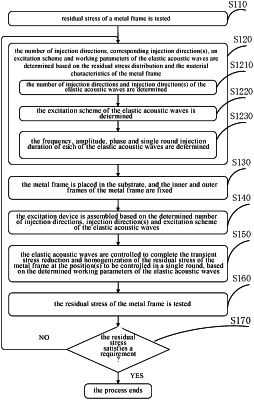| CPC C21D 10/00 (2013.01) | 3 Claims |

|
1. A method for reducing and homogenizing residual stress of a metal frame using elastic acoustic waves, comprising:
determining an injection scheme of elastic acoustic waves using residual stress distribution and material characteristics of a metal frame, wherein the injection scheme at least comprises the number of injection directions, corresponding injection direction(s), an excitation scheme and working parameters of the elastic acoustic waves, wherein the working parameters include at least one of a frequency, an amplitude, a phase and an injection duration;
placing the metal frame in a substrate and fastening inner and outer frames of the metal frame;
assembling an excitation device for the elastic acoustic waves using the determined excitation scheme of the elastic acoustic waves; and
injecting the elastic acoustic waves into the metal frame from at least one direction to perform reduction and homogenization of residual stress of the metal frame, wherein the injected elastic acoustic waves have the determined working parameters,
wherein determining the injection scheme of the elastic acoustic waves further includes:
setting the number of injection directions of the elastic acoustic waves and the corresponding injection direction(s) of the elastic acoustic waves using the residual stress distribution of the metal frame, wherein the injection direction(s) of the elastic acoustic waves is aligned with position(s) to be controlled of the residual stress of the metal frame, and the number of injection directions of the elastic acoustic waves is set to be larger than one when there is more than one position to be controlled for the residual stress of the metal frame, and one injection direction cannot cover the positions to be controlled of the total residual stress, or the residual stress of the metal frame at a single position to be controlled requires the elastic acoustic waves to be injected from more than one direction;
setting the excitation scheme of the elastic acoustic waves using the residual stress distribution of the metal frame and the material characteristics of the metal frame, wherein when an excitation device for the elastic acoustic waves is an ultrasonic vibrator, an ultrasonic horn of the ultrasonic vibrator matching an acoustic velocity of the metal frame is selected and a tool cap is added to an end face of the ultrasonic horn if a size of the position(s) to be controlled of the residual stress of the metal frame is larger than a certain size, and when the excitation device for the elastic acoustic waves is a fluid coupling excitation device, the injection direction of the elastic acoustic waves can be adjusted to facilitate the formation of guided wave(s) at the position(s) to be controlled of the metal frame by adjusting the injection directions of the elastic acoustic waves, and the strength of the guided wave(s) is determined by the energy of the elastic acoustic waves injected from multiple directions and the acoustic impedance of the metal frame; and
setting the working parameters of the elastic acoustic waves, wherein a set frequency of each of the elastic acoustic waves ensures that the acoustic velocity of the material of the metal frame is matched with that of the excitation device, a set amplitude of each of the elastic acoustic waves can ensure the reduction and homogenization effects of the residual stress of the metal frame and does not cause the deformation of the metal frame, and a set phase of each of the elastic acoustic waves is adjusted so that the injected elastic acoustic waves can achieve the energy superposition of the elastic acoustic waves at the position(s) to be controlled.
|